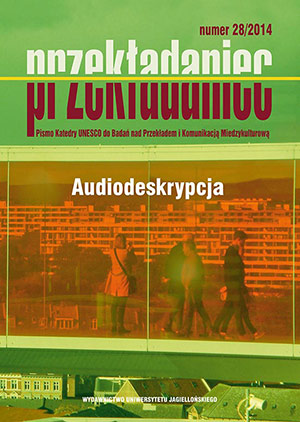Audiodeskrypcja piękna
Audio Description of Beauty
Author(s): Robert WięckowskiSubject(s): Language and Literature Studies
Published by: Wydawnictwo Uniwersytetu Jagiellońskiego
Keywords: audio description; blind; museum; beauty; ekphrasis
Summary/Abstract: Audio description is a technique used for making visual content accessible to people with visual impairments, i.e. the blind and partially sighted. Specially prepared descriptions allow them for independent and competent reception of fi lms, theatre and opera performances, works of art or sport events. The practice and theory of audio description focused primarily on researching and making accessible the descriptions added to audiovisual productions; the question of accessibility of museums and galleries was marginalized. It is the one, however, for years requiring theoretical considerations followed by practical implementation of the solutions developed. This article concentrates on two issues, namely how to convey in audio description the beauty inherent in every work of art, which creates unique aesthetic experience in its receiver, how long such audio description should last and how detailed it should be to meet the perceptive capabilities of the blind and partially sighted. In this article, audio description is subject to analysis carried out until now primarily in relation to literary texts. The author concentrates on the possibilities of conveying, in a verbal description extending over time, the visually perceived beauty, meaning perceived immediately, in the process lasting for a short time. The author also discusses the work of researchers focusing on intersemiotic translation and analyzing the borderline between literature and fi ne arts. Moreover, the article presents the notion of literary ekphrasis, being a description whose aim, while caring about the reader’s aesthetic experience, is to ensure that the reader becomes familiar with the described work of art. Is it possible for the audio description that makes museum exhibits accessible to its target audience to become a special type of ekphrasis? Or should it only draw on solutions proposed by the authors of ekphrases? This article poses the above questions to induce theoretical refl ection. It also points out that research aimed at evaluating the length and level of detail of audio description of the works of art carried out, for the fi rst time ever, by the Polish researchers is on the way to come, as soon as this year.
Journal: Przekładaniec.
- Issue Year: 2014
- Issue No: 28
- Page Range: 109-123
- Page Count: 15
- Language: Polish

